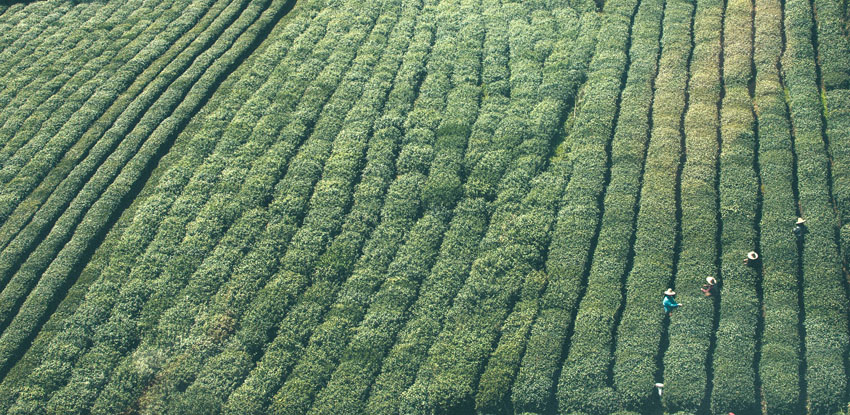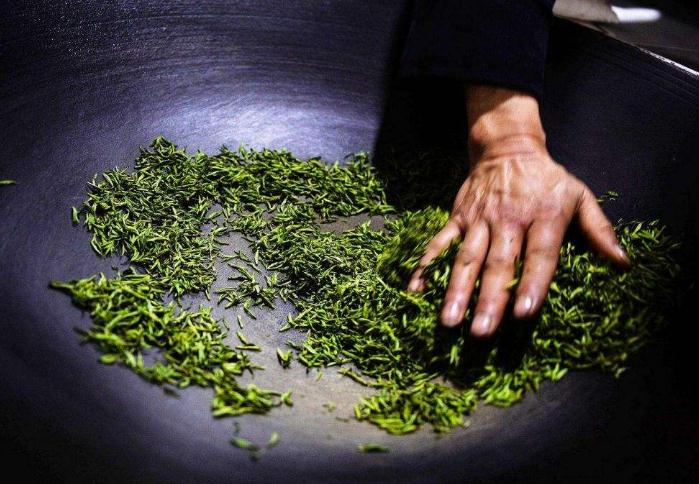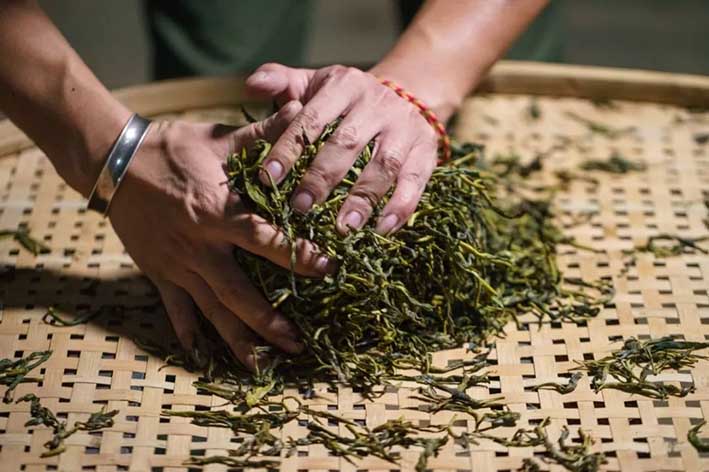All tea comes from Camellia sinensis, an evergreen shrub or tree from southern China and Southeast Asia. From the leaves of this plant, we can obtain, depending on the type of process to which it is subjected, different varieties: green tea, yellow tea, white tea, wūlóng 烏龍, black tea (hóngchá 紅茶), and hēichá 黑茶. To understand the differences between these varieties we must first understand what are the processes that occur in tea, and the steps in which its production consists.
1. Harvest (cǎiqīng 采青):
The collection of the leaves is traditionally done by hand. In the plantations, tea plants are kept as shrubs at an adequate height to allow harvesting, although in some provinces of China there are wild tea trees from which tea is also harvested.

There are different harvesting protocols, which dictate how much of the tea is to be picked. Sometimes it will be only the bud, sometimes it will be the first leaf, or the bud and the first leaf, bud and two leaves, etc. This will directly influence the quality of the tea, since the bud and the first leaves have different amounts of nutrients that affect the taste.
The harvest can be carried out at different times of the year, the most precious being the first spring harvest, which is the one that provides more nutrients and therefore greater complexity of flavour.
2. Withering (wēidiāo 萎凋):
From the moment the leaves are separated from the plant during harvest, they begin to wither. This process is allowed for more or less time according to the variety that is going to be produced.
The leaves are spread on a flat surface, so that they are exposed to the air and soften as they wither, becoming more flexible. This allows the subsequent rolling into different shapes without the leaves breaking. Withering takes between 12 and 18 hours approximately, in which the leaves have to be turned several times to allow homogeneous exposure to air.
3. Enzymatic deactivation (shāqīng 殺青):
Enzymatic deactivation consists of the application of heat to stop the oxidation process, deactivating the enzymes that produce it.
Shāqīng can be done with dry heat, in wok or pan, or by steam. Almost all teas in China use shāqīng with dry heat, while the application of steam to stop oxidation is more characteristic of Japanese teas.
The method used will modify the taste of tea, since the temperatures reached on wok are much higher than those reached by steam, destroying certain bitter components of the leaf and resulting in a sweeter product.

Shāqīng 殺青 on a wok.
It is important to note that the enzymatic cut does not dry the leaf yet, a process that will occur later, but its sole purpose is to deactivate oxidation, and is therefore especially important in the production of green tea.
4. Rolling or kneading (róuniǎn 揉捻):
Róuniǎn encompasses different methods of leaf damaging, such as rolling or kneading. The leaves, already soft, are subjected to a manipulation that breaks the cell wall and exposes its components to the air, extracting their juices.
Róuniǎn gives the leaf its characteristic appearance, which can take the form of a curl, needle, pearl, etc., and makes it impregnated with its own essential oils, providing complexity of aroma.

Róuniǎn 揉捻.
4. Oxidation/fermentation (fājiào 發酵):
If oxidation has not been stopped by enzymatic deactivation, it will begin when the enzymes and essential oils of the leaf are exposed to oxygen in the air during rolling or kneading.
Oxidation triggers changes in the chemical composition and colour of the leaves, turning them brown and reddish.
Parallel to the oxidation process, a simple or non-bacterial fermentation takes place (different from post-fermentation). Both processes, oxidation and fermentation, are inseparable. While oxidation modifies the colour of the leaf, fermentation alters its flavour and aroma.
The duration of this process depends on the climate and the variety produced, but it can occur in a matter of a few hours. Subsequently, the leaves can be rolled and/or oxidized again, although in most types of tea oxidation/fermentation occurs only once.
5. Drying (gānzào 干燥):
It is usually the last step in the production process. The leaves can be roasted or heated quickly to remove the remaining moisture, firmly adhere the cellular fluids to the leaves and allow a good conservation of them.
6. Post-fermentation o bacterial fermentation:
This process only occurs in the variety known as hēi chá 黑茶 and in some types of white tea. Tea is stored under controlled conditions of humidity and temperature, which produce bacterial fermentation, through certain microorganisms that naturally inhabit the leaf (such as bacteria and yeast).
These microorganisms are beneficial to health, modify the taste and aroma of tea over time and provide digestive and probiotic properties.
This process is also known as aging.
Not all varieties are produced following these steps: some follow only a few, while others repeat some of them several times.
In a future article we will see how each of the steps described affects the achievement of one variety of tea or another.
